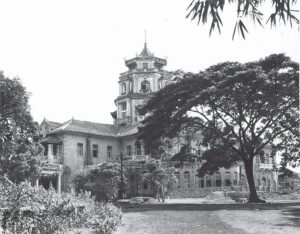Burma’s Ministry of Culture will grant Chin Tsong Palace heritage status and renovate the building as it approaches its 100th anniversary, Kyaw Nyunt, director of Rangoon Division’s Archaeology, National Museum and Library Department, told The Irrawaddy.
Located on Kaba Aye Pagoda Road in Rangoon, the palace, widely known as ‘Kanbawza Yeiktha,’ was built during the colonial period and is a blend of Eastern and Western architectural designs. “The building is architecturally fascinating and built strong,” said Kyaw Nyunt. “As it has started to show signs of decay, we have decided to maintain it for its durability.”
The magnificent five-storey building was constructed by Chinese businessman Lim Chin Tsong between 1915 and 1919 at a cost of around 2 million rupees. Lim Chin Tsong’s father migrated to Burma from China in 1861 and began trading in rice. After graduating from Rangoon College, Lim inherited his father’s business after he died in 1888.
He greatly expanded the business, branching into rubber cultivation, textiles and the oil, mineral mining and banking sectors. He became a regional agent for Burmah Oil Company in 1891 and later a member of parliament and the owner of Rangoon Turf Club. In 1919, he was awarded the Order of the British Empire for his work fund raising during World War I.

Lim Chin Tsong’s business was adversely affected when the British government banned rice exports following a rise in rice prices in 1921. Lim died suddenly of a heart attack two years later and his family was forced to leave the palace the following year due to outstanding debts.
Under Japanese rule in 1941-45, Chin Tsong Palace housed the All Burma Broadcasting Station. The palace was transformed into a hotel after World War II and its name was changed to Kanbawza Yeiktha in 1951.
Currently, the Fine Arts Department under the Ministry of Culture maintains an office and an arts school within the building. “It is good that the Archeology, National Museum and Library Department will take responsibility to maintain the building,” said Yan Naing Oo, director-general of the Fine Arts Department. “It is difficult for us to maintain the building as it has many floors. Besides, we have to get it repaired annually as Rangoon usually receives high rainfall,” he said.

















